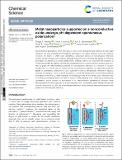| dc.contributor.author | Wesley, Thejas S | |
| dc.contributor.author | Hülsey, Max J | |
| dc.contributor.author | Westendorff, Karl S | |
| dc.contributor.author | Lewis, Noah B | |
| dc.contributor.author | Crumlin, Ethan J | |
| dc.contributor.author | Román-Leshkov, Yuriy | |
| dc.contributor.author | Surendranath, Yogesh | |
| dc.date.accessioned | 2024-09-20T18:13:11Z | |
| dc.date.available | 2024-09-20T18:13:11Z | |
| dc.date.issued | 2023 | |
| dc.identifier.uri | https://hdl.handle.net/1721.1/156921 | |
| dc.description.abstract | Electrochemical polarization, which often plays a critical role in driving chemical reactions at solid–liquid interfaces, can arise spontaneously through the exchange of ions and/or electrons across the interface. However, the extent to which such spontaneous polarization prevails at nonconductive interfaces remains unclear because such materials preclude measuring and controlling the degree of interfacial polarization via standard (i.e., wired) potentiometric methods. Herein, we circumvent the limitations of wired potentiometry by applying infrared and ambient pressure X-ray photoelectron spectroscopies (AP-XPS) to probe the electrochemical potential of nonconductive interfaces as a function of solution composition. As a model class of macroscopically nonconductive interfaces, we specifically probe the degree of spontaneous polarization of ZrO2-supported Pt and Au nanoparticles immersed in aqueous solutions of varying pH. Shifts in the Pt-adsorbed CO vibrational band position evince electrochemical polarization of the Pt/ZrO2–water interface with changing pH, and AP-XPS reveals quasi-Nernstian shifts of the electrochemical potential of Pt and Au with pH in the presence of H2. These results indicate that spontaneous proton transfer via equilibrated H+/H2 interconversion spontaneously polarizes metal nanoparticles even when supported on a nonconductive host. Consequently, these findings indicate that solution composition (i.e., pH) can be an effective handle for tuning interfacial electrical polarization and potential at nonconductive interfaces. | en_US |
| dc.language.iso | en | |
| dc.publisher | Royal Society of Chemistry | en_US |
| dc.relation.isversionof | 10.1039/d3sc00884c | en_US |
| dc.rights | Creative Commons Attribution-Noncommercial | en_US |
| dc.rights.uri | http://creativecommons.org/licenses/by-nc/3.0/ | en_US |
| dc.source | Royal Society of Chemistry | en_US |
| dc.title | Metal nanoparticles supported on a nonconductive oxide undergo pH-dependent spontaneous polarization | en_US |
| dc.type | Article | en_US |
| dc.identifier.citation | Chem. Sci., 2023,14, 7154-7160 | en_US |
| dc.contributor.department | Massachusetts Institute of Technology. Department of Chemical Engineering | en_US |
| dc.contributor.department | Massachusetts Institute of Technology. Department of Chemistry | en_US |
| dc.relation.journal | Chemical Science | en_US |
| dc.eprint.version | Final published version | en_US |
| dc.type.uri | http://purl.org/eprint/type/JournalArticle | en_US |
| eprint.status | http://purl.org/eprint/status/PeerReviewed | en_US |
| dc.date.updated | 2024-09-20T18:03:41Z | |
| dspace.orderedauthors | Wesley, TS; Hülsey, MJ; Westendorff, KS; Lewis, NB; Crumlin, EJ; Román-Leshkov, Y; Surendranath, Y | en_US |
| dspace.date.submission | 2024-09-20T18:03:43Z | |
| mit.journal.volume | 14 | en_US |
| mit.journal.issue | 26 | en_US |
| mit.license | PUBLISHER_CC | |
| mit.metadata.status | Authority Work and Publication Information Needed | en_US |
